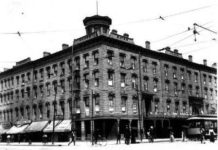
For more than 90 years, a house in Cheltenham called the Donore House (now St. Anne) which was built for Henry Swinhoe in 1860 was the site of a haunting by a female apparition. The house located on the corner of All Saints Road and Pitville Circus Road. The haunting known as the Morton Case or the Cheltenham Haunting, was investigated by Frederick W.H. Myers, one of the founders of the then fledgling Society for Physical Research (SPR), and is considered one of the best-documented hauntings in the SPR archives. The majority of the sightings occurred between 1882 and 1889, but the phantom was viewed independently by at least 17 persons.
Swinhoe’s first wife died in 1866. He remarried in 1869, but his new wife, Imogen Hutchins Swinhoe, left him shortly before his death in 1876, in part because instead of giving her his first wife’s jewelry, he hid it in a safe under the living room floor. Imogen, who died two years after her husband, never returned to the house while she was still alive; however, she is thought to be the one who returned to haunt the house.
After Mr. Swinhoe’s death, the house’s next lessee, a Mr. L., died six months after moving in. The Cheltenham house sat empty for the next four years. Until April 1882, retired Army captain Frederick William Despard, aged fifty-three, his forty-six-year-old wife Harriet, together with their seven children, Freda (20), Rosina (19), Edith (18), Lillian (15), Henry (16), Mable (13) and Wilfred (6), moving in. They moved from Lansdown Road in Cheltenham, the town where they had been living for the previous half dozen or so years.

Although paranormal phenomena had apparently occurred earlier, hauntings now began in earnest, with 19-year-old Rosina Despard (later Rosina Morton) being the one who most often saw the spectre: a tall woman, dressed in black, holding a handkerchief over part of her face (which made positive identification impossible). The ghost often passed down the stairs; she almost always paused in the living room before moving down the hall to the door to the garden, where she disappeared. On at least one occasion, one of the Despard daughters saw her in the garden. The phantom appeared to be solid and aware of her surroundings (moving around furniture, for example), but she never acknowledged anyone’s attempt to communicate with her.
Eventually, almost everyone in the household saw the figure, including, apparently, the family dogs, who often howled or shrank in fear even when no apparition was visible. In addition to the human apparition, the house experienced the traditional knocks and bumps in the night.
In 1885, the Despard home was investigated by Frederic W.H. Myers of the Society for Psychical Research. (Rosina had published her own experiences in the society’s journal the previous year.) At Myers’s suggestion, Rosina attempted to take photographs of the spirit, but none produced a recognizable image













